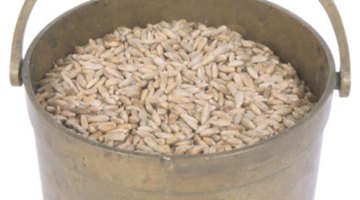Bugs That Feast on Mold
Many insects feed on a variety of organic matter, algae, plants and flowers. Certain insects known as mold mites feed primarily on mold. These pests are not usually noticed, unless they are large in number. Mold mites gather in areas where moisture and high humidity abound.

These mites are often difficult to control when infestations are heavy.
Identification
Mold mites belong to a group of insects known as tyroglyphid mites, along with grain mites, cheese mites and flour mites. These mites are only found where moisture and high humidity are abundant, causing the development of mold which is the mold mite's primary food source. According to Iowa State University, mold mites have been found in grain, seeds, flour, straw, wallpaper, bulbs, furniture, cereals and dried food products.
Effects
Mold mites do not bite or sting humans and are harmless. These mites do not feed on clothing, fabric or furniture or cause damage to the structure of a home. Mold mites eat mold and fungi and live where the humidity is constantly high. The presence of skin casts in stored grains or other foods is often indicative of heavy mold mite infestation. When humans come into contact with mold mites, they often develop a mild type of contact dermatitis known as "grocer's itch." Mold mites often cause a sweet odor when infestations are heavy. Mold mites are difficult to control where humidity is very high and when mite populations are high.
Cultural Control
Controlling mold mites requires several cultural control methods. Reducing the humidity where the mites are found is key to controlling or eliminating infestations. This is especially important where grains, nuts and cheese are stored. Sealing all stored food in airtight containers is another important aspect of mold mite control. Controlling any moisture in areas of stored food will help reduce humidity and mold mite development.
Chemical Control
Insecticides in a spray or fogger form may help reduce mold mite infestations. However, for these insecticides to be effective they must reach the area where mites live. Mold mites multiply rapidly, so insecticides must reach them at their source for best results. Insecticides only work when combined with cultural control methods to reduce infestations and keep conditions unfavorable for their development.
The Drip Cap
- Many insects feed on a variety of organic matter, algae, plants and flowers.
- Mold mites eat mold and fungi and live where the humidity is constantly high.
- Sealing all stored food in airtight containers is another important aspect of mold mite control.
- Controlling any moisture in areas of stored food will help reduce humidity and mold mite development.
- Mold mites multiply rapidly, so insecticides must reach them at their source for best results.
References
Writer Bio
Tracy Hodge has been a professional writer since 2007. She currently writes content for various websites, specializing in health and fitness. Hodge also does ghostwriting projects for books, as well as poetry pieces. She has studied nutrition extensively, especially bodybuilding diets and nutritional supplements.
Photo Credits
- Hemera Technologies/PhotoObjects.net/Getty Images
- Hemera Technologies/PhotoObjects.net/Getty Images
More Articles



